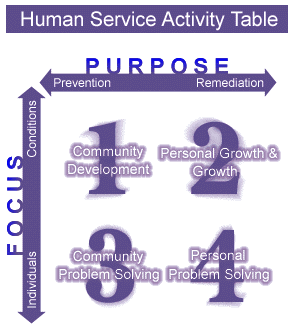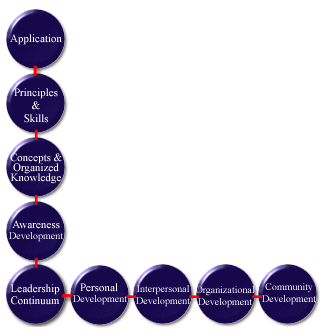
Purpose Continuum~Focus Continuum~The Four Quadrants
Arenas of Human Service Activity: Putting Prevention in Context
If people are to discover and use practical, workable and effective approaches to prevention, they must first be able to identify and distinguish between various types of human service activity. "Human service" is viewed in a very broad sense. It includes many efforts, public and private, professional and voluntary, formal and informal, that seek to meet the needs of people. These efforts include the service activities that occur in and through educational, justice, recreational, health and mental health, religious, economic, and other governmental and civic institutions and organizations.
The framework presented here takes two features of a human service activity into consideration. These are the purpose and the focus of the activity.

Leadership Continuum
Local Oregon Community Children and Youth Service Commissioners and community members value leadership as a critical element in addressing the needs of children, youth and their families. Developing leadership skills is a process best illustrated by the chart below.

Vertical Axes: Personal Leadership Competencies
The vertical axis describes the four phases of knowledge and skills an individual acquires through formal educational programs and informational life experiences.
Awareness Stage Initial introduction of a concept, issue, or topic.
The purpose of a particular human service activity can be stated in many ways. The Purpose Continuum presented here uses as its opposite ends the words prevention and remediation as they have been defined.
Every human service activity has a purpose, and for planning and action it is important to state clearly what that purpose is. On the Purpose Continuum of this framework can be seen human service activities that extend from the most positive and assertive efforts to create conditions and personal attributes that promote the well-being of people, at one end, to the reactive, corrective efforts of remediation, at the other. Seeing these activities in relation to a continuum provides for the possibility that a particular service design will include some preventive and some remedial features, thus falling somewhere near the middle of the continuum.
The focus of human service activity can also be described in many ways. In their helpful book, Consultation, Blake and Mouton describe several units of change. These include the individual, group, intergroup, organization and the larger social system. This listing is useful, and each of these units of change can appropriately be placed on the Focus Continuum in logical order. We might also add such words as family, peer group, neighborhood and other descriptions that denote tangible and definable entities that serve as foci of human service activity.
In this framework the two words that are used to describe the ends of the Focus Continuum are individual and conditions. Obviously, much human service activity is focused upon the individual. As we move beyond the individual to consider the various relationships that people become engaged in and the circumstances under which these relationships occur, the word "conditions" becomes useful. This refers to a set of circumstances that in some way is important. These might be conditions within a family, a school classroom, a neighborhood, a labor union, a city council, a human service agency or any grouping of people or situation around which clear boundaries can be established for action purposes. The relevant characteristics of those conditions for change purposes can usually be described by the people involved. A focus on conditions makes it possible to deal with some strategic aspects of human service activity that the more traditional approaches to human services have tended to deemphasize, discourage or avoid.
The Focus Continuum becomes useful as ways are considered to shape service activities in order to obtain desirable results. The changes sought through human service activity involve changes in behavior on someone's part. The usual focus on "client" change is useful up to a point, but the limited concept of the "helper-client" relationship is descriptive of only a portion, and a relatively small one, of human service activity.
Other common ways of describing relationships in human service organizations are "provider-recipient," "teacher-student," "doctor-patient," "probation officer-probationer," and "leader-participant." All of these pairs of words describe transactions in which there is a giver and a recipient, a person with solutions and a person with problems or needs. These kinds of "subject-object" relationships have more relevance in some types of human service activity than in others. It can be generalized that, as human service activity is currently designed, activities which are remedial in nature require this type of transaction. The relationships most appropriate for preventive service activity may well call for a different quality of relationship among resource people, a difference to be explored in detail.
The Four Quadrants of Human Service Activity
By using the Purpose and Focus Continua it becomes possible to identify four specific arenas of human service activity, as illustrated in Figure 1. The Purpose Continuum is place across the top of the square and the Focus Continuum along the left margin. Four arenas of human service activity result from this juxtaposition:
QUADRANT 1 This is preventive activity which focuses on conditions, and is called "Community Development."
QUADRANT 2 This is preventive activity which focuses on individuals, and is called "Personal Growth and Development."
QUADRANT 3 This is remedial activity which focuses on conditions, and is called "Community Problem Solving."
QUADRANT 4 This is remedial activity which focuses on individuals, and is called "Personal Problem Solving."
Taken from "Discovering the Meaning of Prevention," by William Lofquist.
This information was prepared by the Chandler Center for Community Leadership, 2600 NW College Way, Bend, Oregon 97701-5998, Phone (541) 388-8361, Fax (541) 383-8002, Electronic Mail, hoguet@oes.orst.edu.
The Center is a collaboration of Oregon State University Extension Service, Central Oregon Community College and the Chandler Center. The Center began in 1992 to foster community-based leadership and to encourage individuals and community groups to take part in governing. The Center focuses primarily, but not exclusively, on developing and sustaining public policy issues, community systems, and collaborations.
Chandler Center for Community Leadership